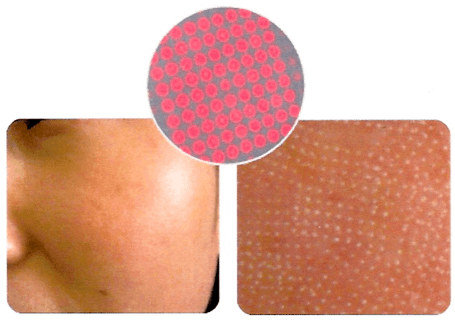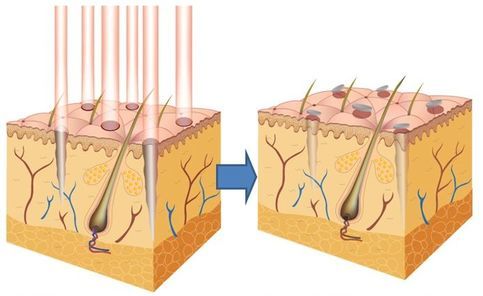FRACTIONAL CO2 LASER
What is special about CO2 lasers?
CO2 lasers belong to the group of powerful laser devices and have a very long wavelength of 10600 nm. This physical property ensures that it reaches much deeper layers when applied. This way it can evaporate the tissues by generating high heat. The strong vaporizer effect of flat CO2 lasers limits the field of application. But technological improvements have made CO2 laser much more functional without reducing power.
What is the characteristic of fractional CO2 lasers?

The advances in computer and optical technology enable the CO2 laser to apply point targeting so that the areas in between remain intact. The effect of laser beams one micron in size, which is much smaller than a millimetre, brings significant gains. Concentrated pulses of light affect only the targeted area rather than a larger region which is a big advantage.
What is the ablative and non-ablative effect?
The classical CO2 lasers have ablative properties because it evaporates the treated skin turning it into an open wound. Therefore, the need for anaesthesia creates undesirable conditions such as a long healing period and frequent side effects. Fractional CO2 laser devices are controlled-ablative as the laser beam applied does not affect the entire region. Significant advantages arise from the fact that the microscopic beam is applied exclusively to the treated target points avoiding the healthy tissue. No anaesthesia is needed as there is no pain, no open wounds, almost no side effects and the healing period is very short. Most importantly, patients can turn back to their daily life immediately.
When is the fractional CO2 laser applied?

Fractional CO2 lasers are used rather widely:
- Removing fine and moderate lines
- Reduction of deep wrinkles
- Increasing skin quality and elasticity by eliminating large pores and rough skin appearance
- Removing skin stains such as sun damage, post-natal spots such as melasma, age spots, acne spots
- Removal of acne scars
- Removal or reduction of scars
- Treatment of burn scars and surgical scars
In what particular conditions should it not be used?
There are conditions when fractional CO2 laser devices should not be used.
- In patients with uncontrolled diabetes
- During pregnancy
- Acute herpes infections
- Open wounds and infections
What rules should be observed before the treatment?
Fractional CO2 laser resurfacing is a powerful treatment method, so some precautions should be taken to prevent various problems after the treatment. First of all, it may be necessary to avoid taking certain medicines. The use of anti-clotting drugs such as aspirin, heparin, drugs containing retinoids (Roaccutane, Tretinoin, Acnelyse, Differin, Zoretanin) can be problematic. Besides, tetracycline, estrogen, progesterone, chloroquine should be used with caution. If a patient had skin peeling procedures such as chemical peeling and microdermabrasion, the treatment should be delayed for a short while.

How is fractional CO2 laser treatment performed?
An anaesthetic cream is applied approximately 30 minutes before the laser treatment to minimize the possible discomfort. The procedure on the face usually lasts about half an hour. Slight oedema, redness, and microscopic spots can occur after the application. In approximately 48 hours crusting begins. The crusts are peeled after 4 - 7 days, leaving the skin underneath renewed and rejuvenated.
During this period patients can use makeup to go on with their social occasions. Depending on the indication fractional CO2 laser treatment is performed in 2-5 sessions with 4-week intervals. For example, in the case of superficial stains or fine lines, even 2 sessions are sufficient. 5 sessions may be needed for deep acne scars. Fractional CO2 laser treatment performs evaporation of microscopic skin columns which initiates natural repair processes. In addition to the tightening of the collagen fibres, new collagen fibres are formed.
Rules to be observed after the treatment?
After fractional CO2 laser treatment, it is necessary to apply antibiotic cream several times a day for 4-5 days. An intermittent cold compress can be applied for redness and oedema. One of the most important issues to be considered after the procedure is sun protection. Due to laser-induced peeling, stain formation can occur if the skin is exposed to sunlight. Therefore, sunscreen with high protection factors should be used.

